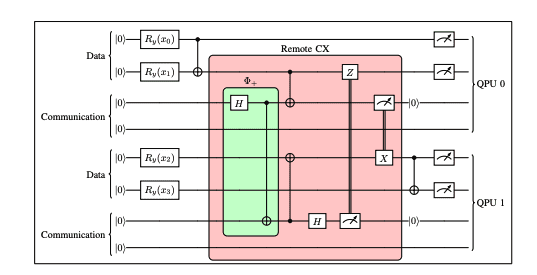Scaling quantum computers to tackle complex problems represents a significant hurdle in the field, and researchers are actively exploring ways to connect multiple smaller processors to achieve greater computational power. Leo Sünkel, Jonas Stein, and Jonas Nüßlein, all from the Institute for Informatics LMU Munich, along with Tobias Rohe and Claudia Linnhoff-Popien, investigate how best to design quantum circuits for these distributed systems. Their work evaluates different circuit architectures, specifically focusing on the patterns of entanglement required for communication between processors, and demonstrates that standard circuit designs do not always perform optimally in a distributed setting. By simulating an eight-qubit circuit across four processors, the team reveals that carefully chosen architectures, which minimise the need for inter-processor entanglement, can deliver improved performance, particularly when faced with the inevitable noise present in real quantum hardware. This research provides crucial insights into designing effective quantum algorithms for a future where distributed quantum computing becomes a reality.
Distributed VQE with Networked Quantum Processors
This research explores distributed quantum computing, focusing on its potential to accelerate Variational Quantum Eigensolver (VQE) algorithms, crucial for quantum chemistry and materials science. Distributed quantum computing offers a promising solution by connecting multiple smaller quantum processors, overcoming the limitations of single-processor systems. The team investigates how computations can be divided and performed across these interconnected processors. The research utilizes simulations to model distributed quantum systems, as building large-scale quantum networks remains a significant challenge.
Scientists explore strategies for dividing quantum circuits into smaller parts and investigate communication protocols for exchanging quantum information efficiently. Different network arrangements are analyzed to determine which best optimizes performance and minimizes errors. The findings demonstrate that distributed quantum computing can significantly speed up VQE calculations, particularly for complex molecules and materials. Future research directions include validating these simulations with experiments on real quantum hardware, exploring scalability to even larger numbers of processors, and developing fault-tolerant quantum networks. Improving the efficiency of the hybrid quantum-classical optimization process and applying this technology to other quantum algorithms are also key areas for investigation.
Simulating Distributed Quantum Computation with Sixteen Qubits
Scientists developed a novel method to simulate distributed quantum computation, addressing the challenge of scaling quantum processing units for complex algorithms. The team engineered a system with four quantum processors, each equipped with qubits for computation and communication, to explore how circuits can be divided and executed across multiple machines. Rather than building a physical quantum network, they innovatively simulated this distributed environment using a single, larger quantum circuit, allowing for precise control and analysis. The core of the methodology involved a “remote-CX protocol” to simulate operations between qubits residing on different processors.
To rigorously compare performance, circuits were first optimized in a non-distributed fashion, and then these optimized parameters were applied to the simulated distributed circuit under noisy conditions. This allowed scientists to isolate the impact of distributed computation and noise on circuit performance. The study evaluated four distinct circuit architectures, including a standard baseline, a fully entangled circuit, and two architectures incorporating alternating local and global layers. This systematic approach enabled the team to identify architectures that minimize the need for costly inter-processor communication, delivering improved performance under noisy conditions and paving the way for more scalable quantum algorithms.
Distributed Quantum Computation Achieves Eight Qubit Simulation
Scientists successfully demonstrated distributed quantum computing by simulating an eight-qubit circuit across four quantum processing units. Each unit contained qubits for computation and communication, enabling the execution of circuits beyond the capacity of a single unit. The team employed a remote-CX protocol to perform non-local operations, effectively connecting the units and allowing for distributed computation. Experiments focused on a binary classification task, rigorously testing circuit performance under both ideal and noisy conditions. The research reveals that standard circuit architectures do not consistently deliver optimal performance in this distributed setting. Instead, circuits designed with minimized remote operations between units exhibited superior noise robustness, achieving better results when subjected to noise. However, the experiments also confirmed that a certain degree of entanglement is necessary to attain acceptable performance levels, highlighting the importance of strategic connectivity.
Entanglement Arrangement Impacts Distributed Quantum Performance
This research evaluated the performance of various circuit architectures within a distributed quantum computing paradigm, utilizing four quantum processing units. The team assigned qubits to individual units and implemented two-qubit operations between them using a remote-CX protocol, allowing circuits exceeding the capacity of a single unit to be executed. Experiments involved training circuits for a binary classification task and then testing their performance under noisy conditions, mirroring realistic quantum hardware limitations. The results demonstrate that the arrangement of entanglement within these circuits significantly impacts performance.
Architectures that balance local and remote operations prove more suitable for distributed quantum computing. The study provides a simplified framework for evaluating the effects of remote operations and different architectures, offering initial insights into suitable designs for this emerging computing model. The authors acknowledge that simulating and training circuits with a larger number of qubits on a network simulator remains computationally challenging, representing a direction for future work. They also highlight the need for further investigation into the impact of noise and the development of more robust designs tailored for distributed quantum systems.
